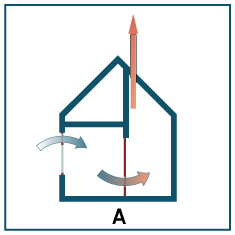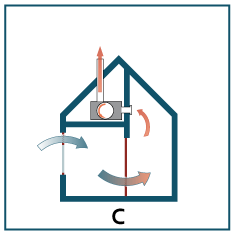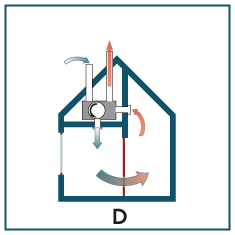

Good ventilation is not only important for your health. It also improves the effectiveness of the fireplace and the cooking hood, and reduces unpleasant odours and allergies.
Ventilation requires a ventilation system. This supplies fresh air via dry spaces (bedroom, living room). The air then flows via the hallway and staircase to humid spaces (kitchen, bathroom) where it is expelled by the ventilation system.
Four recognised ventilation systems exist that vary from fully natural ventilation to mixed ventilation and simple or dual-flow controlled mechanical ventilation (CMV). These systems are indicated with the letters A to D.
In addition, there are also individual appliances for decentralised ventilation. These can be useful for purifying the air in usually humid areas such as the bathroom, kitchen or storage room.

System A is an installation that does not require any mechanical help. Fresh air is supplied naturally through vents built in the windows.
The air intake of these vents can be adjusted manually.
Polluted air is expelled via vertical ducts in the bathroom or kitchen (damp spaces).
| Benefits | Disadvantages |
|
|

A natural supply of air is not always possible due to high levels of ambient noise, rooms without windows, or because the space to be ventilated is isolated inside an apartment building. In this case, the mechanical supply of fresh air is an option.
A controlled supply of fresh outside air is forced through the home using a fan. Air is expelled and flows as with system A.
This system is quite rare in Belgium.
| Benefits | Disadavantages |
|
|

The natural exhaust of air is not always possible if you have renovated your home thoroughly. In this case you can install a ventilation system with a mechanical air exhaust. Damp and polluted air is extracted through air ducts in damp rooms such as the kitchen and bathroom.
The classic C system uses continuous air intake. The C+ system is self-regulating and refreshes the air based on the humidity or CO2 level.
| Benefits | Disadavantages |
|
|

This system is controlled automatically from start to finish because air is supplied and expelled through fans. A network of ducts throughout the home supplies this air to vents in each room without the different air flows crossing each other.
The level of ventilation can also be controlled with this system using sensors (humidity, CO2).
| Benefits | Disadvantages |
|
|
Another option is to install a simple air outlet somewhere in the house in order, for example, to avoid moisture accumulation or odour nuisance. This means, however, that the heat is also carried away. If used regularly, this is obviously a waste of energy.
To prevent this, there is so-called decentralised ventilation, which works according to the same principle as controlled mechanical ventilation (CMV) with double flux. These individual appliances:
No ventilation system?
Then ventilate briefly but vigorously by opening the windows for a few minutes. Particularly efficient in winter, because cold air is drier than warm air. So it is better to open the windows wide for 5 to 10 minutes than to leave them ajar or in the tilted position all day long.
Source: Energiesparen.be
Subscribe to our newsletter and stay informed about energyfacts.